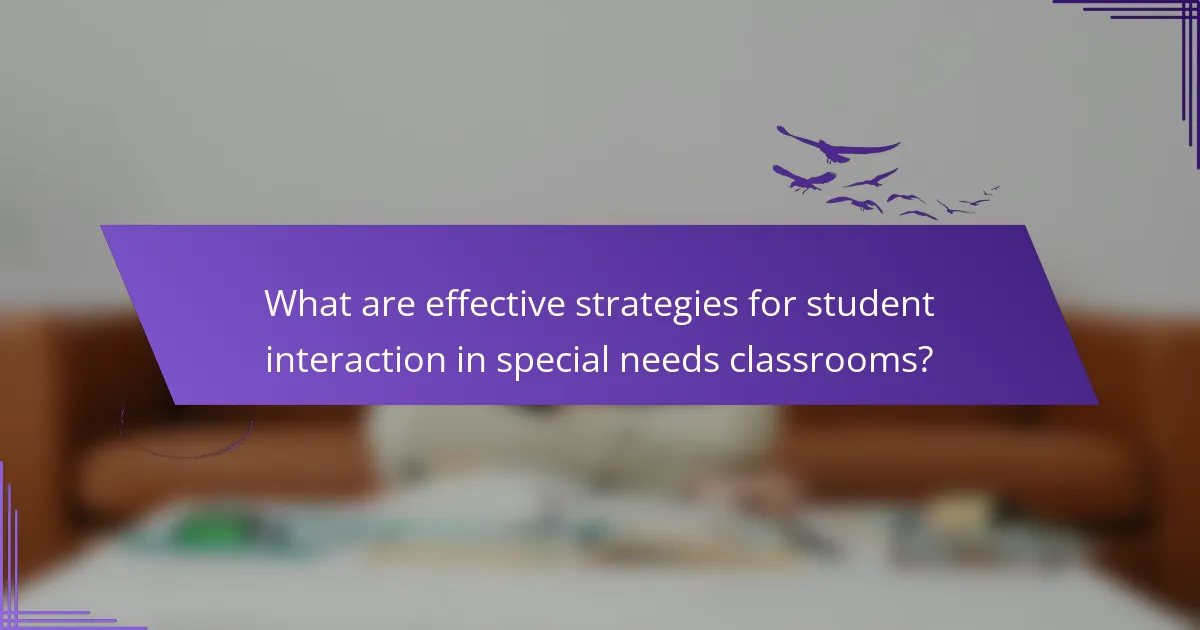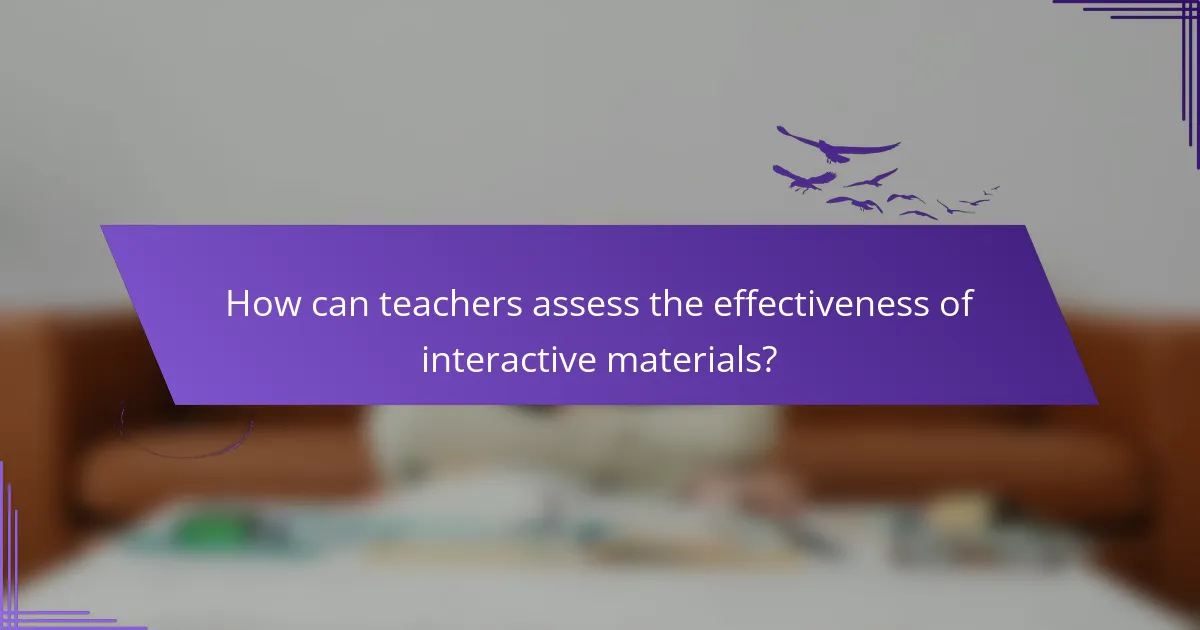Interactive classroom materials play a crucial role in enhancing engagement for students with special needs by offering varied methods for learning and communication. By accommodating different learning styles, these resources not only make education more accessible but also foster collaboration and socialization among students. Implementing effective strategies for student interaction can significantly boost confidence and communication skills, creating a more inclusive and supportive learning environment.

How can interactive materials enhance special needs engagement?
Interactive materials significantly improve engagement for students with special needs by providing diverse ways to learn and communicate. These resources cater to various learning styles, making education more accessible and enjoyable.
Visual aids for communication
Visual aids play a crucial role in enhancing communication for students with special needs. Tools such as picture cards, charts, and infographics can simplify complex concepts and help convey messages more clearly.
Incorporating visual aids into lessons can facilitate understanding and retention. For instance, using a visual schedule can help students anticipate transitions and reduce anxiety. Consider using bright colors and clear images to capture attention and maintain interest.
Hands-on activities for sensory learning
Hands-on activities are essential for sensory learning, allowing students to engage with materials physically. Activities like building models, using manipulatives, or conducting simple experiments can stimulate multiple senses and reinforce learning.
These interactive experiences can be tailored to individual needs. For example, using textured materials can help students with tactile sensitivities explore concepts in a way that feels comfortable and engaging. Ensure that activities are varied to maintain interest and cater to different sensory preferences.
Adaptive technology for personalized learning
Adaptive technology offers personalized learning experiences for students with special needs by accommodating various learning challenges. Tools like speech-to-text software, interactive apps, and specialized devices can enhance accessibility and engagement.
When selecting adaptive technology, consider the specific needs of each student. For example, using a tablet with educational apps can provide interactive learning opportunities that traditional methods may not offer. Regularly assess the effectiveness of these tools to ensure they meet evolving educational goals.

What are effective strategies for student interaction in special needs classrooms?
Effective strategies for student interaction in special needs classrooms include fostering collaboration, utilizing peer support, and engaging students through interactive activities. These approaches can enhance communication skills, build confidence, and promote socialization among students with diverse needs.
Collaborative group projects
Collaborative group projects encourage teamwork and communication among students with special needs. By working together on a common task, students can learn to share ideas, delegate responsibilities, and support each other’s strengths. It’s essential to ensure that group sizes are manageable, typically between three to five students, to facilitate meaningful interactions.
When planning these projects, consider using clear guidelines and roles to help students understand their contributions. For example, assigning specific tasks such as researcher, presenter, or note-taker can help students focus and engage more effectively. Regular check-ins can also provide necessary support and keep the group on track.
Peer mentoring programs
Peer mentoring programs pair students with special needs with their peers, promoting social interaction and learning through guided support. This strategy can help build friendships and improve social skills, as mentors often model appropriate behaviors and communication techniques. Pairing students with similar interests can enhance the effectiveness of these programs.
To implement a successful peer mentoring program, it’s crucial to provide training for mentors, focusing on empathy, patience, and effective communication. Regular feedback sessions can help mentors refine their approaches and ensure that the needs of their mentees are being met.
Interactive games for social skills
Interactive games designed for social skills development can significantly enhance student engagement in special needs classrooms. These games often involve role-playing, turn-taking, and problem-solving, which are essential for building social competence. Options like board games, card games, or digital games can be tailored to various skill levels.
When selecting games, consider those that encourage collaboration and communication, such as team-based challenges or cooperative storytelling. Incorporating elements of fun and competition can motivate students to participate actively. Be mindful of each student’s abilities to ensure inclusivity and adjust the complexity of the games accordingly.

Which online courses offer training in interactive classroom materials?
Several online platforms provide courses focused on interactive classroom materials that enhance engagement for students with special needs. These courses cover various strategies and techniques to create inclusive learning environments.
Coursera: Special Needs Education
Coursera offers a range of courses specifically designed for special needs education, focusing on interactive materials that cater to diverse learning requirements. These courses often include video lectures, readings, and peer-reviewed assignments to reinforce learning.
Participants can expect to learn about creating adaptable lesson plans and utilizing technology to support students with different abilities. Many courses are developed in collaboration with leading universities and may offer certificates upon completion.
edX: Inclusive Teaching Strategies
edX provides courses that emphasize inclusive teaching strategies, helping educators design interactive materials that engage all students, including those with disabilities. The platform features courses from reputable institutions, ensuring high-quality content and expert instruction.
Courses typically cover topics such as differentiated instruction and the use of assistive technologies. Educators can gain practical insights into modifying existing materials to meet the needs of special needs students effectively.
Udemy: Interactive Learning Techniques
Udemy hosts a variety of courses focused on interactive learning techniques, which are essential for fostering student interaction in the classroom. These courses are often more affordable and can be accessed at any time, making them convenient for busy educators.
Topics include gamification, hands-on activities, and the integration of digital tools to enhance engagement. Educators can find practical examples and actionable tips to implement in their classrooms immediately.

What criteria should educators consider when selecting interactive materials?
Educators should consider alignment with learning objectives, accessibility features, and engagement potential when selecting interactive materials. These criteria ensure that the materials effectively support diverse learners, particularly those with special needs, while fostering interaction among students.
Alignment with learning objectives
Interactive materials must align with the specific learning objectives of the curriculum. This means that the content should directly support the skills and knowledge that educators aim to impart, ensuring that students can connect their learning experiences with the intended outcomes.
For example, if the objective is to enhance reading comprehension, materials should include interactive reading exercises that promote critical thinking and analysis. Educators can use a checklist to evaluate whether the materials meet these objectives before implementation.
Accessibility features
Accessibility features are crucial for ensuring that all students, including those with disabilities, can engage with interactive materials. Look for resources that comply with accessibility standards, such as WCAG, and offer options like text-to-speech, adjustable font sizes, and alternative text for images.
For instance, materials that provide captions for videos or allow for keyboard navigation can significantly enhance the learning experience for students with hearing or mobility impairments. Always test materials with diverse learners to identify any barriers to access.
Engagement potential
Engagement potential refers to how well interactive materials capture students’ interest and encourage participation. Materials should be designed to be interactive, allowing students to actively participate rather than passively consume information.
Consider using gamified elements, such as quizzes or interactive simulations, which can motivate students and enhance their learning experience. Additionally, observe student reactions to different materials to gauge their engagement levels and adjust your selections accordingly.

How can teachers assess the effectiveness of interactive materials?
Teachers can assess the effectiveness of interactive materials by gathering direct feedback from students, observing their engagement levels, and evaluating learning outcomes. These methods provide insights into how well the materials facilitate learning and student interaction.
Student feedback and surveys
Collecting student feedback through surveys is a straightforward way to gauge the effectiveness of interactive materials. Teachers can use simple questionnaires that ask students to rate their enjoyment, understanding, and engagement with the materials. Open-ended questions can also provide qualitative insights into what students liked or found challenging.
Consider using anonymous surveys to encourage honest responses. Aim for a mix of quantitative ratings and qualitative comments to get a well-rounded view of student experiences.
Observation of engagement levels
Observing students during lessons can reveal how engaged they are with interactive materials. Teachers should look for signs of active participation, such as students asking questions, collaborating with peers, or showing enthusiasm. Noting the duration of sustained attention can also help assess engagement.
To make this process effective, teachers can create a simple checklist to track engagement indicators during lessons. This can include metrics like participation rates, group interactions, and student focus, which can be analyzed over time to identify trends.
Assessment of learning outcomes
Evaluating learning outcomes is crucial for understanding the impact of interactive materials on student achievement. Teachers should compare assessment scores before and after using these materials to determine if there is a significant improvement in understanding and retention of the subject matter.
Incorporating formative assessments, such as quizzes or project-based evaluations, can provide immediate feedback on student learning. This approach allows teachers to adjust their materials and methods based on what works best for their students, ensuring continuous improvement in teaching effectiveness.


